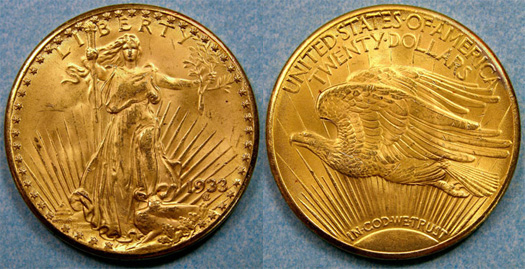With a rich and storied history, the 1933 Saint Gaudens Double Eagle represents one of the most famous rarities within American numismatics. Although there was a sizable original mintage, all pieces were supposed to be melted following Franklin Roosevelt’s presidential order to recall federal gold. The handful of examples that managed to escape into private hands have been subject to government seizure and court battles. As it now stands, there is only one example of the coin that is legal for private ownership, which recently sold for a record shattering price.

On March 9, 1933, President Franklin D. Roosevelt issued Executive Order 6102, prohibiting gold ownership with very few exceptions. Despite the order, the production of the 1933 Saint-Gaudens Double Eagles at the Philadelphia Mint commenced, and a total of 445,000 coins were struck and delivered with instructions not to be paid out. Two coins were sent to the Smithsonian Institution for inclusion within the National Numismatic Collection. A small number were also sent to the Assay Commission where they were destroyed during the testing process. The remainder were held as uncurrent coin until they were eventually ordered to be melted, which would have left only the two museum pieces and no examples available to collectors.
Nonetheless, at least 20 examples of the 1933 Double Eagle managed to escape the melting pot. In the ensuing years, a total of nine examples of the coin were either seized or voluntarily surrendered and destroyed. One collector attempted to fight the confiscation in court and lost, providing legal precedent that private ownership of any 1933 Double Eagle is illegal. Nonetheless, in 1944 one example was sold privately for the collection of King Farouk of Egypt. An export license was requested and inadvertently granted by the Treasury Department, since they did not realize the significance of the date. Thus, one example of the coin was legally exported out of the United States.
In 1996, an example of the 1933 Double Eagle believed to be the Farouk specimen surfaced when a London coin dealer attempted to bring the coin into the United States for a private sale. The purported buyers turned out to be government agents and the coin was seized by the Secret Service. A five-year legal battle for ownership of the coin would take place. Primarily based on the export license that had been inadvertently granted many years ago, a settlement was reached before the jury trial. The United States Treasury agreed an auction of the coin, with the proceeds split between the seller and the government. In 2002, the coin would be sold for $7,590,000 at an auction conducted by Sotheby’s and Stack’s. In 2021, the coin was offered at auction again and realized the staggering price of $18,872,250. This remains the only specimen of the coin which is legal for private ownership.
In a final twist, ten more examples of the 1933 Saint-Gaudens Double Eagle surfaced in 2003 when the descendants of coin dealer Israel Switt discovered the coins in a safe deposit box. The coins were provided to the United States Mint for authentication, but the Mint refused to return the coins or initiate forfeiture proceedings. An ensuing trial and series of appeals would eventually find that the coins were the property of the United States government. The ten coins are currently held by the government at Fort Knox Bullion Depository.
1933 Double Eagle Specifications
- Designer: Augustus Saint Gaudens
- Composition: 90% gold, 10% copper
- Weight: 33.436 grams
- Diameter: 34 mm
- Mints: Philadelphia, San Francisco
1933 Double Eagle Mintages
- 1933: 445,500 (13 known)
Image: Smithsonian Institution

